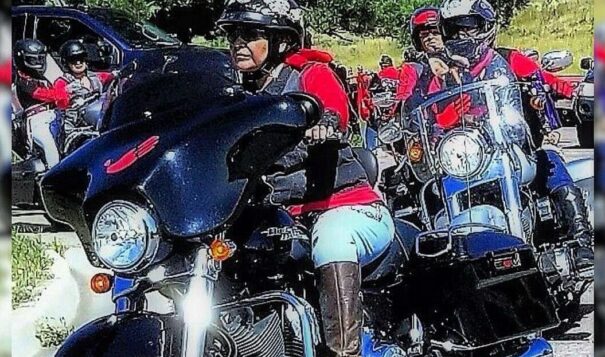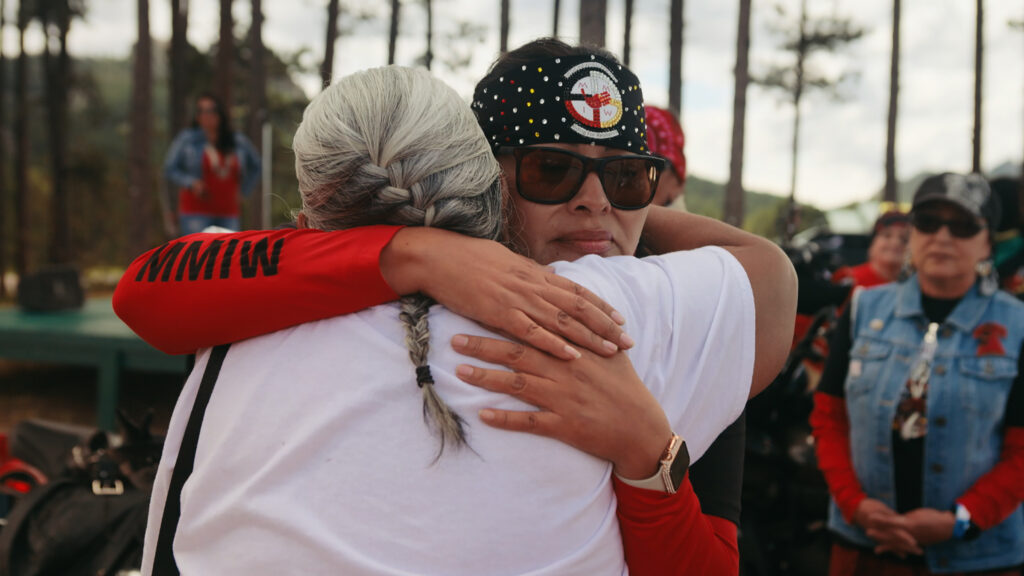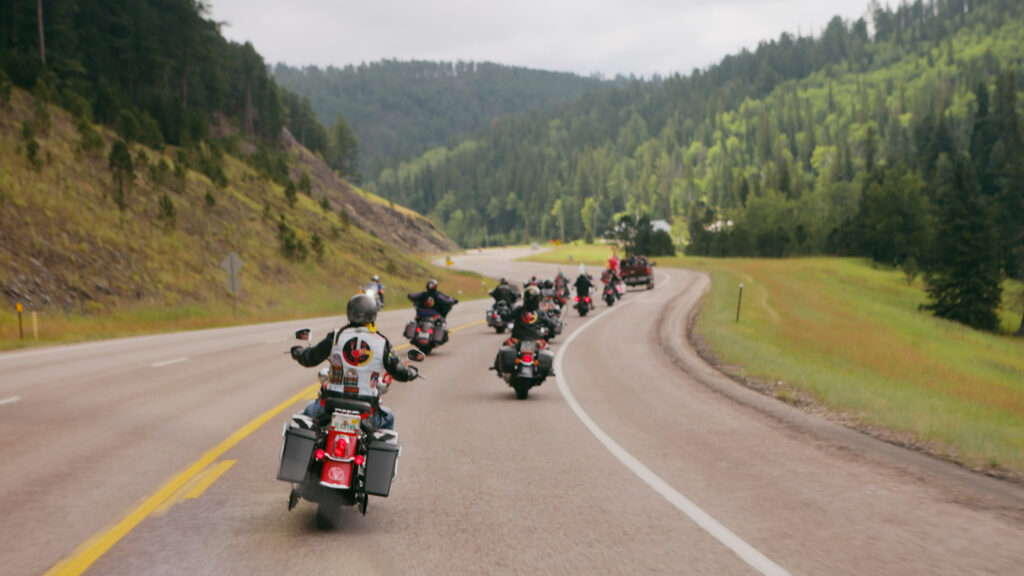News Based on facts, either observed and verified directly by the reporter, or reported and verified from knowledgeable sources.
“We Ride For Her” film sparks action to combat the MMIP crisis
 At the Aug. 9, 2020 Sturgis Medicine Wheel Ride, Native women bikers launch from the sacred site of Bear Butte to raise awareness about missing and murdered relatives. Photo credit/ Talli Nauman
At the Aug. 9, 2020 Sturgis Medicine Wheel Ride, Native women bikers launch from the sacred site of Bear Butte to raise awareness about missing and murdered relatives. Photo credit/ Talli Nauman
Documentary on Native women’s motorcycle group, now on tour
A recent screening of “We Ride For Her” ignited conversations around the Missing and Murdered Indigenous Peoples crisis. An epidemic of more than 5,500 missing or murdered Indigenous women and girls persists across the United States, according to the Native women who made the independent film.
“We Ride For Her” is a short documentary about an Indigenous women’s motorcycle club riding to end the crisis. The film focuses on one of the riders, Heather Taken Alive, who is searching for her missing sister while seeking healing for her family.
Around 50 people came out to Bismarck State College’s screening on April 21. After an introduction by Mandan, Hidatsa and Arikara citizen Prairie Rose Seminole, movie co-director, attendees watched the 18-minute film. Following the showing, a panel including former North Dakota State Rep. Ruth Buffalo, McLean County Sheriff J.R. Kerzmann and Seminole launched a discussion. Russ McDonald, the former Spirit Lake tribal chairman, acted as emcee during the Q&A portion of the event.
The film started as a six-month project, but that timeframe expanded to three years when Seminole felt the heavy heart of the story. She and her crew wanted to do it right and be respectful of those who were sharing their stories. “We had challenges. They’re more interpersonal in a way of like, ‘Hey, how do we take care of each other?’ or ‘Hey, how do we interview without triggering and shutting down our people that we’re interviewing?’” recalled Seminole.

She considers “We Ride For Her” a community-owned film because the story of lost relatives affects all Indigenous communities in the United States and Canada. About 20 organizations helped fund production, including the Red Sand Project.
Self-described experiential artist activist Molly Gochman initiated the Red Sand Project in 2014, as a way to spread awareness about human trafficking and modern slavery. Her first art installation of the project was in Miami. She filled the cracks of sidewalks with red sand in and around the Art Basel Miami Beach pavilion. According to the website, the red grains of sand symbolize those who fall through the cracks, “whether the cracks of our social, economic, and political systems or those of our personal consciousness.”
Gochman later expanded the work to offer Red Sand Project toolkits and information on the website. This encourages people to participate, physically engage in the cause and create discussions. Toward the end of the Bismarck screening, attendees received packets of red sand from the project to distribute across sidewalk cracks in their communities.
Native and non-Native attendees asked the panelists how they could support those affected by MMIP. Seminole redirected participants to the “We Ride For Her” website. The Call For Action page provides resources such as information from the National Indigenous Women’s Resource Center, two human trafficking hotlines, a Speaking Our Truth podcast by the NIWRC, the Savanna’s Act, Not Invisible Act, an Indigenous ally toolkit and MMIP organizing toolkit.
“If you’re a Native or white person, I’m pretty sure you don’t care what color skin or what the badge looks like –– you’re just looking for someone to help put the fire out.”
J.R. Kerzmann- a citizen of the MHA Nation
Kerzmann, a citizen of the MHA Nation, discussed limitations on case investigation. A lack of resources, including a nationwide police shortage, overwhelms law enforcement efforts. With a shortage of police, remaining officers may take longer to address situations. This is especially significant where tribal police have sole jurisdiction over their Native citizens and an entire reservation with only one or two officers patrolling.
Kerzmann has worked with the Bureau of Indian Affairs and tribes to better fill reservation needs in first-response situations. Simple agreements, such as holding tribal citizens until tribal police can take them into custody, have helped address problems much quicker. “If you’re a Native or white person, I’m pretty sure you don’t care what color skin or what the badge looks like –– you’re just looking for someone to help put the fire out,” Kerzmann said.
Several participants also asked if federal intervention could combat the crisis. Buffalo said there is a deeper-rooted issue that the government has a limited ability to control. “I think it comes down to human decency,” said Buffalo. “People still do not view Natives, in my opinion, as being humans or a whole person. That was the sort of premise for a lot of legislation that was put forward.”
The Not Invisible Act, Savanna’s Act and Violence Against Women Act are recent relevant laws, while others are proposed.

Seminole emphasized that discussions between Natives and non-Natives about Missing and Murdered Indigenous Peoples is vital for coming up with better solutions. “We can have this open awareness to have a deeper conversation about how to unpack this issue,” said Seminole. “We’re your neighbors. We’re getting affected by this in ways you are not, so let’s make this better together.”
While having these conversations may be painful, McDonald said, it’s important for Native and non-Natives to come together to show support to families as they grieve and begin healing from their losses. “When we talk about grief, there’s a similarity in how we process the loss of our relatives,” said McDonald. “I think we need to come together and be those good people –– to be good relatives.”
Seminole hopes this film can inspire people to take action. Particularly, she hopes non-Natives listen to Native community members who are grieving and begin to speak up about the issue as well.
“When we’re talking about trauma they can easily disassociate and say, ‘Well that doesn’t affect us so I don’t need to be a part of it’,” said Seminole. “We wanted to do something different and speak to it, but we hope that you walk away understanding that you’ve got a role to play in Native communities.”
Since its March world premiere at Austin’s South by Southwest Festival, “We Ride For Her” has been on the film festival circuit. The documentary is currently available for community screenings as well. In the future, Seminole hopes to make the film more accessible to viewers by putting the documentary on a streaming service.
Sourcing & Methodology Statement:
Red Sand Project. (n.d.). https://redsandproject.org/about/
Red Sand Project. (n.d.). We Ride For Her. https://www.werideforher.com/reel
Dateline:
BISMARCK, N.D.
